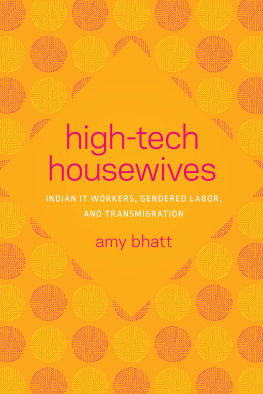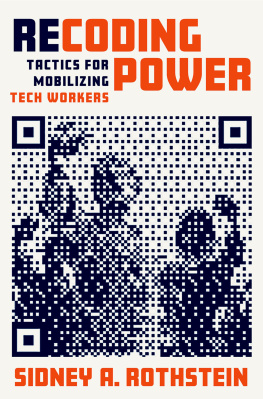

Padma Kaimal
K. Sivaramakrishnan
Anand A. Yang
SERIES EDITORS
High-Tech Housewives
Indian IT Workers, Gendered Labor, and Transmigration
AMY BHATT
UNIVERSITY OF WASHINGTON PRESS
Seattle
Copyright 2018 by the University of Washington Press
Printed and bound in the United States of America
Composed in Minion Pro, typeface designed by Robert Slimbach
222120191854321
All rights reserved. No part of this publication may be reproduced or transmitted in any form or by any means, electronic or mechanical, including photocopy, recording, or any information storage or retrieval system, without permission in writing from the publisher.
Portions of ; and Amy Bhatt, Resident Non-resident Indians: Gender, Labor and the Return to India, in Transnational Migration to Asia: The Question of Return, ed. Michiel Baas, 5572 (Amsterdam: Amsterdam University Press, 2015), reprinted with permission of Amsterdam University Press.
University of Washington Press
www.washington.edu/uwpress
Library of Congress Cataloging-in-Publication Data on file
ISBN 978-0-295-74354-7 (Hardcover)
ISBN 978-0-295-74355-4 (Paperback)
ISBN 978-0-295-74356-1 (Ebook)
To my favorites, Kevin Bromer and Anika Bromer
To my eternal supporters, Ranjana and Pradip Bhatt
Contents
Acknowledgments
When I first moved to Seattle in 2004, I became involved with Chaya Seattle (now API Chaya), an advocacy organization aimed at ending family-based violence and creating community among South Asian women in the region. As the tech industries in the Pacific Northwest exploded, so too did the South Asian population. In particular, the arrival of new temporary workers from India, along with women coming on family reunification visas, were a vital part of this IT boom. Some of these women came to the attention of Chaya staff as they faced isolation and sometimes violence in their home lives. Although not all H-4 holders experienced abuse, many were stuck in remote suburbs and were largely absent from the larger South Asian community institutions in the area. I began volunteering on a small project aimed at reaching out to those women, which ultimately brought me into contact with some of the participants of this study. While the issue of H-4 vulnerability was still my foremost concern, I grew interested in a larger question: what role does the family play in sustaining and promoting transnational migration and how do women fare as a result of that movement?
To answer that question and others, I tapped into a rich network of Indian information technology (IT) workers, thanks to introductions from colleagues such as Tapoja Chaudhuri, Sharmistha Ghosh, and Bill Nordwall. Through those introductions, I met nearly a hundred current and former H-1B and H-4 visa holders who were willing to share their stories and experiences with me. It is their stories that drive this study; they are the embodied subjects of transnationalism whose labor is a major force in the IT industry globally. While my focus was predominantly on the Pacific Northwest, it quickly became clear to me that their stories did not end with their arrival to the United States. Instead, their initial migration on the H-1B or H-4 visa was a stepping-stone along a circuitous journey that often included moving back and forth between India and the United States. In order to trace the consequences of these repeated migrations, I traveled to Bangalore and Hyderabad, India, to visit some of the former H-1B and H-4 visa holders I had met in Seattle and to meet others like them who had moved back after living in the United States for long stretches. Even though living in India was not always their final goal, the R2I (return to India) proved to be an important key to understanding how families were practicing a form of transnationalism that was tied to their immediate and future aspirations, but also constrained by the global job market, immigration restrictions in the United States, and family concerns. My time in India was considerably aided by Madhu Chawla, my gracious hostess in Delhi; the Murty family, who treated me like a family member during my time in Hyderabad; and Carol Upadhya and the National Institute of Advanced Studies in Bangalore. Special thanks goes to the Bhatt and Pancholi families in Mumbai and Pune, who not only helped me navigate the transportation, hotel, and visa logistics required of ethnographic fieldwork abroad, but also taught me the true value of transnational family life.
This book and the years of research it encompasses would not have been possible without the many sources of financial and intellectual support that I received along the way. At the University of Washington, I am thankful for the resources provided by the Department of Gender, Women and Sexuality Studies, a UW presidential writing fellowship, the Chester Fritz Fellowship for International Study and Exchange, five Foreign Language and Area Studies Fellowships from the South Asia Center at the Jackson School of International Studies, the Society of Scholars Fellowship at the Simpson Center for the Humanities, and the Project in Interdisciplinary Pedagogy Fellowship from UW Bothell. The mentorship of Priti Ramamurthy, David Allen, Chandan Reddy, Sareeta Amrute, Judith Howard, Amanda Swarr, Shirley Yee, Tani Barlow, Rachel Chapman, Michael Shapiro, Heidi Pauwels, Nikhil Singh, Bruce Burgett, Julie Shayne, and S. Charusheela pushed and refined my thinking and writing. The comrades-in-writing and thinking that I met during my time in Seattle provided inspiration and much-needed company, laughs, and happy hours during the hard, lonely years of work: Thank you, Michelle McGowen, Teresa Mares, Madhavi Murthy, Juned Shaikh, Nalini Iyer, Sarah Burnett, Abel Kerevel, Matt Bunt, Dave Citrin, Uma Rao, Gita Mehrotra, and Shiwani Srivastava (who, in particular, taught me a great deal about finding my voice and writing for a broader audience).
I have also had the good fortune to be surrounded by supportive colleagues at the University of Maryland, Baltimore County, who have helped me to refine this project. The resources from a Summer Faculty Fellowship from the College of Arts, Humanities and Social Sciences and a Summer Faculty Research Fellowship and a Scholarly Completion Fund Award from the Dresher Center for the Humanities allowed me to expand my data collection in India and Seattle and to provide a longitudinal view of Indian IT transmigration. I have benefited greatly from the rich intellectual community at UMBC, where I have shared and workshopped my writing among colleagues in Gender and Womens Studies, Asian Studies, Language Literacy and Culture, Media and Communication Studies, and American Studies. In particular, I thank Carole McCann, Scott Casper, Constantine Vaporis, Anna Shields, Theo Gonzalves, Jason Loviglio, Fan Yang, Rebecca Adelman, Susan McDonough, Jessica Berman, Dawn Biehler, Nicole King, Tamara Bhalla, Viviana McManus, Mejdulene Shomali, and Christine Mair. I also thank Elle Trusz, Kimberley Hardaway, and Elle Everhart for the outstanding administrative support they provided, and the graduate and undergraduate assistants with whom I have had the pleasure of working: Richa Sabu, Saba Ghulamali, Emerald Christopher, and most importantly, Sherella Cupid, whose responsiveness and attention to detail helped me better my writing and teaching. Kate Drabinski and Christine Mallinson deserve special recognition for acting as vital sounding boards and because they are simply awesome and brilliant. Baltimore would not be home without you.
Next page














